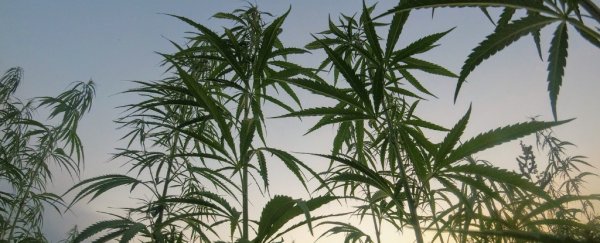Cannabis is a complex plant with a complex history. It's been cultivated for at least 6,000 years, but because of its modern legal status, we're still learning new things about its medicinal benefits.
While most of us have heard of the plant's pain-relieving cannabinoids, such as CBD, there's a lesser known class of compounds that deserves our attention.
Flavonoids are a group of natural substances that are thought to hold anti-oxidative, anti-inflammatory, and anti-carcinogenic properties. These compounds are found in fruits, vegetables, flowers, tea, wine, and, yes, even cannabis.
In 1986, researcher Marilyn Barrett at the University of London was the first to identify two cannabis flavonoids, known as cannflavin A and cannflavin B, both of which were found to have anti-inflammatory benefits 30 times more effective than Aspirin.
But while the flavonoid pathway has been extensively studied in several other plants, for decades, there has been no specific data on their biosynthesis in cannabis. Now, for the first time, researchers in Canada have uncovered how the cannabis plant creates these important pain-relieving molecules.
"Our objective was to better understand how these molecules are made, which is a relatively straightforward exercise these days," explains Tariq Akhtar, a molecular and cellular biologist at the University of Guelph.
"There are many sequenced genomes that are publicly available, including the genome of Cannabis sativa, which can be mined for information. If you know what you're looking for, one can bring genes to life, so to speak, and piece together how molecules like cannflavins A and B are assembled."
Using a combination of genomics and biochemistry techniques, the team was able to pinpoint which genes were responsible for creating these two cannflavins. Their findings provide the first evidence of a unique genetic pathway in Cannabis sativa plants, which uses two enzymes to ultimately create cannflavin A and B.
Extracting and purifying these compounds from a cannabis plant, however, just isn't practical. Akhtar epxlained to The Toronto Star that these cannflavins only make up about .014 per cent of the plant's weight, so fields and fields of cannabis would have to be grown in order to capture these anti-inflammatory benefits.
As a result, the researchers hope to use this new information to metabolically engineer their own pain-relieving medicine outside of the cannabis plant. To achieve this, they will be working with the Toronto-based company, Anahit International Corp., which has already licensed a patent from their university.
"The problem with these molecules is they are present in cannabis at such low levels, it's not feasible to try to engineer the cannabis plant to create more of these substances," says co-author Steven Rothstein, who studies the molecular and genetic qualities of crop plants at University of Guelph.
"We are now working to develop a biological system to create these molecules, which would give us the opportunity to engineer large quantities."
Without some of the side effects of other painkillers, the authors think the synthesis of these molecules could make a big difference in the pharmaceutical industry.
Previous studies have shown that the vast majority of patients prefer cannabis to opioids when managing their pain, which suggests there's ample market for a drug that mimics its benefits.
"There's clearly a need to develop alternatives for relief of acute and chronic pain that go beyond opioids," says Akhtar.
"These molecules are non-psychoactive and they target the inflammation at the source, making them ideal painkillers."
The research has been published in Phytochemistry.
